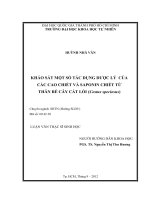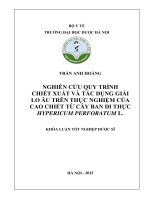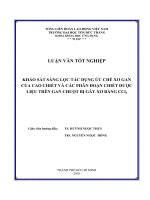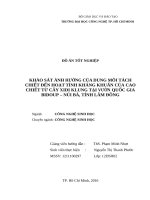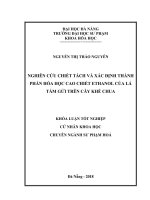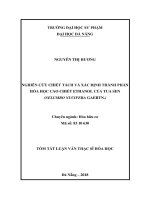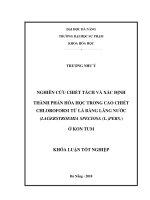Đánh giá hoạt tính kháng vi sinh vật của cao chiết các chủng niêm khuẩn
Bạn đang xem bản rút gọn của tài liệu. Xem và tải ngay bản đầy đủ của tài liệu tại đây (507.07 KB, 7 trang )
��������������������������������������������������������������������������������������������������������������������������������������������������������������������������������������������������������������������������������������������������������������������������������������������������������������������������������������������������������������������������������������������������������������������������������������������������������������������������������������������������������������������������������������������������������������������������������������������������������������������������������������������������������������������������������������������������������������������������������������������������������������������������������������������������������������������������������������������������������������������������������������������������������������������������������������������������������������������������������������������������������������������������������������������������������������������������������������������������������������������������������������������������������������������������������������������������������������������������������������������������������������������������������������������������������������������������������������������������������������������������������������������������������������������������������������������������������������������������������������������������������������������������������������������������������������������������������������������������������������������������������������������������������������������������������������������������������������������������������������������������������������������������������������������������������������������������������������������������������������������������������������������������������������������������������������������������������������������������������������������������������������������������������������������������������������������������������������������������������������������������������������������������������������������������������������������������������������������������������������������������������������������������������������������������������������������������������������������������������������������������������������������������������������������������������������������������������������������������������������������������������������������������������������������������������������������������������������������������������������������������������������������������������������������������������������������������������������������������������������������������������������������������������������������������������������������������������������������������������������������������������������������������������������������������������������������������������������������������������������������������������������������������������������������������������������������������������������������������������������������������������������������������������������������������������������������������������������������������������������������������������������������������������������������������������������������������������������������������������������������������������������������������������������������������������������������������������������������������������������������������������������������������������������������������������������������������������������������������������������������������������������������������������������������������������������������������������������������������������������������������������������������������������������������������������������������������������������������������������������������������������������������������������������������������������������������������������������������������������������������������������������������������������������������������������������������������������������������������������������������������������������������������������������������������������������������������������������������������������������������������������������������������������������������������������������������������������������������������������������������������������������������������������������������������������������������������������������������������������������������������������������������������������������������������������������������������������������������������������������������������������������������������������������������������������������������������������������������������������������������������������������������������������������������������������������������������������������������������������������������������������������������������������������������������������������������������������������������������������������������������������������������������������������������������������������������������������������������������������������������������������������������������������������������������������������������������������������������������������������������������������������������������������������������������������������������������������������������������������������������������������������������������������������������������������������������������������������������������������������������������������������������������������������������������������������������������������������������������������������������������������������������������������������������������������������������������������������������������������������������������������������������������������������������������������������������������������������������������������������������������������������������������������������������������������������������������������������������������������������������������������������������������������������������������������������������������������������������������������������������������������������������������������������������������������������������������������������������������������������������������������������������������������������������������������������������������������������������������������������������������������������������������������������������������������������������������������������������������������������������������������������������������������������������������������������������������������������������������������������������������������������������������������������������������������������������������������������������������������������������������������������������������������������������������������������������������������������������������������������������������������������������������������������������������������������������������������������������������������������������������������������������������������������������������������������������������������������������������������������������������������������������������������������������������������������������������������������������������������������������������������������������������������������������������������������������������������������������������������������������������������������������������������������������������������������������������������������������������������������������������������������������������������������������������������������������������������������������������������������������������������������������������������������������������������������������������������������������������������������������������������������������������������������������������������������������������������������������������������������������������������������������������������������������������������������������������������������������������������������������������������������������������������������������������������������������������������������������������������������������������������������������������������������������������������������������������������������������������������������������������������������������������������������������������������������������������������������������������������������������������������������������������������������������������������������������������������������������������������������������������������������������������������������������������������������������������������������������������������������������������������������������������������������������������������������������������������������������������������������������������������������������������������������������������������������������������������������������������������������������������������������������������������������������������������������������������������������������������������������������������������������������������������������������������������������������������������������������������������������������������������������������������������������������������������������������������������������������������������������������������������������������������������������������������������������������������������������������������������������������������������������������������������������������������������������������������������������������������������������������������������������������������������������������������������������������������������������������������������������������������������������������������������������������������������������������������������������������������������������������������������������������������������������������������������������������������������������������������������������������������������������������������������������������������������������������������������������������������������������������������������������������������������������������������������������������������������������������������������������������������������������������������������������������������������������������������������������������������������������������������������������������������������������������������������������������������������������������������������������������������������������������������������������������������������������������������������������������������������������������������������������������������������������������������������������������������������������������������������������������������������������������������������������������������������������������������������������������������������������������������������������������������������������������������������������������������������������������������������������������������������������������������������������������������������������������������������������������������������������������������������������������������������������������������������������������������������������������������������������������������������������������������������������������������������������������������������������������������������������������������������������������������������������������������������������������������������������������������������������������������������������������������������������������������������������������������������������������������������������������������������������������������������������������������������������������������������������������������������������������������������������������������������������������������������������������������������������������������������������������������������������������������������������������������������������������������������������������������������������������������������������������������������������������������������������������������������������������������������������������������������������������������������������������������������������������������������������������������������������������������������������������������������������������������������������������������������������������������������������������������������������������������������������������������������������������������������������������������������������������������������������������������������������������������������������������������������������������������������������������������������������������������������������������������������������������������������������������������������������������������������������������������������������������������������������������������������������������������������������������������������������������������������������������������������������������������������������������������������������������������������������������������������������������������������������������������������������������������������������������������������������������������������������������������������������������������������������������������������������������������������������������������������������������������������������������������������������������������������������������������������������������������������������������������������������������������������������������������������������������������������������������������������������������������������������������������������������������������������������������������������������������������������������������������������������������������������������������������������������������������������������������������������������������������������������������������������������������������������������������������������������������������������������������������������������������������������������������������������������������������������������������������������������������������������������������������������������������������������������������������������������������������������������������������������������������������������������������������������������������������������������������������������������������������������������������������������������������������������������������������������������������������������������������������������������������������������������������������������������������������������������������������������������������������������������������������������������������������������������������������������������������������������������������������������������������������������������������������������������������������������������������������������������������������������������������������������������������������������������������������������������������������������������������������������������������������������������������������������������������������������������������������������������������������������������������������������������������������������������������������������������������������������������������������������������������������������������������������������������������������������������������������������������������������������������������������������������������������������������������������������������������������������������������������������������������������������������������������������������������������������������������������������������������������������������������������������������������������������������������������������������������������������������������������������������������������������������������������������������������������������������������������������������������������������������������������������������������������������������������������������������������������������������������������������������������������������������������������������������������������������������������������������������������������������������������������������������������������������������������������������������������������������������������������������������������������������������������������������������������������������������������������������������������������������������������������������������������������������������������������������������������������������������������������������������������������������������������������������������������������������������������������������������������������������������������������������������������������������������������������������������������������������������������������������������������������������������������������������������������������������������������������������������������������������������������������������������������������������������������������������������������������������������������������������������������������������������������������������������������������������������������������������������������������������������������������������������������������������������������������������������������������������������������������������������������������������������������������������������������������������������������������������������������������������������������������������������������������������������������������������������������������������������������������������������������������������������������������������������������������������������������������������������������������������������������������������������������������������������������������������������������������������������������������������������������������������������������������������������������������������������������������������������������������������������������������������������������������������������������������������������������������������������������������������������������������������������������������������������������������������������������������������������������������������������������������������������������������������������������������������������������������������������������������������������������������������������������������������������������������������������������������������������������������������������������������������������������������������������������������������������������������������������������������������������������������������������������������������������������������������������������������������������������������������������������������������������������������������������������������������������������������������������������������������������������������������������������������������������������������������������������������������������������������������������������������������������������������������������������������������������������������������������������������������������������������������������������������������������������������������������������������������������������������������������������������������������������������������������������������������������������������������������������������������������������������������������������������������������������������������������������������������������������������������������������������������������������������������������������������������������������������������������������������������������������������������������������������������������������������������������������������������������������������������������������������������������������������������������������������������������������������������������������������������������������������������������������������������������������������������������������������������������������������������������������������������������������������������������������������������������������������������������������������������������������������������������������������������������������������������������������������������������������������������������������������������������������������������������������������������������������������������������������������������������������������������������������������������������������������������������������������������������������������������������������������������������������������������������������������������������������������������������������������������������������������������������������������������������������������������������������������������������������������������������������������������������������������������������������������������������������������������������������������������������������������������������������������������������������������������������������������������������������������������������������������������������������������������������������������������������������������������������������������������������������������������������������������������������������������������������������������������������������������������������������������������������������������������������������������������������������������������������������������������������������������������������������������������������������������������������������������������������������������������������������������������������������������������������������������������������������������������������������������������������������������������quan trọng của nhóm niêm
khuẩn trong việc sản xuất các hợp chất sinh học chống
lại các bệnh truyền nhiễm khác nhau.
Lời cảm ơn
Nghiên cứu được tài trợ bởi Quỹ phát triển Khoa học
và Công nghệ - Đại học Nguyễn Tất Thành, mã đề tài
2021.01.49/HĐ-KHCN.
Tài liệu tham khảo
1.Mohr, K.I.J.M. (2018), Diversity of Myxobacteria—we only see the tip of the iceberg. 2018. 6(3): p. 84.
2.Wenzel, S.C. and R. Müller (2010), Myxobacteria–Unique Microbial Secondary Metabolite Factories. 2010.
3.Diez, J., et al. (2012), Myxobacteria: natural pharmaceutical factories. 2012. 11(1): p. 1-3.
4.Weissman, K.J. and R.J.N.p.r. Müller (2009), Myxobacterial secondary metabolites: bioactivities and modesof-action. 2010. 27(9): p. 1276-1295.
5.Nguyễn Thị Ngọc Yến, N.T.N., Nguyễn Thị Lệ Trinh, Võ Thị Nhàn, Đinh Thị Lan Linh, Nguyễn Đinh Nga,
Nguyễn Tú Anh (2021), Sàng lọc hoạt tính chống oxy hóa của các chủng niêm khuẩn phân lập từ đất. Tạp chí Y
Dược học, 2021. 26: p. 45-49.
6.Shin, H., et al. (2013), Production of Antimicrobial Substances by Strains of Myxobacteria Corallococcus and
Myxococcus. 41(1): p. 44-51.
7.Leber, A.L., (2020). Clinical Microbiology Procedures Handbook. John Wiley & Sons.
8.Weissman, K.J. and R. Müller (2010), A brief tour of myxobacterial secondary metabolism. Bioorganic &
Medicinal Chemistry, 2009. 17(6): p. 2121-2136.
9.Charousová, I., J. Medo, and S.J.A.o.B.S. Javoreková (2017), Isolation, antimicrobial activity of myxobacterial
crude extracts and identification of the most potent strains. 2017. 69(3): p. 561-568.
10. Gaspari, F., et al., Myxobacteria isolated in Israel as potential source of new anti-infectives. J Appl
Microbiol, 2005. 98(2): p. 429-39.
11. Elshikh, M., et al. (2016), Resazurin-based 96-well plate microdilution method for the determination of
minimum inhibitory concentration of biosurfactants. Biotechnology Letters, 2016. 38(6): p. 1015-1019.
Đại học Nguyễn Tất Thành
Tạp chí Khoa học & Cơng nghệ Số 16
44
Evaluation of antimicrobial activities of myxobacteria extracts
Nguyen Thi Ngoc Yen1, Dinh Thi Lan Linh2, Nguyen Phuong Cham1, Nguyen Thi Kim Hong1,
Vo Thi Nhan1, Nguyen Dinh Nga2, Nguyen Tu Anh2
1
Faculty of Pharmacy, Nguyen Tat Thanh University
Faculty of Pharmacy, University of Medicine and Pharmacy, Ho Chi Minh City
2
Abstract The antimicrobial effects of the total extracts on VY/3 medium of 43 myxobacteria isolates in Vietnam
were screened on 5 bacterial strains: MSSA, MRSA, S. faecalis, E. coli, P. aeruginosa, 5 fungal strains of A.
niger, Penicillium sp., Mucor sp., Rhizopus sp., and C. albicans using the agar well diffusion assay. There were
41/43 (95.3 %) samples showing activities against at least one test microorganism, with higher activities against
filamentous fungi (ranging from (48.8-69.8) % in 4 fungal strains) than against bacteria, and the ability to inhibit
Gram-positive bacteria better than Gram-negative. Two strains NC02, NC11 (belonging to genus Myxococcus),
which showed high inhibitory capacity, were determined the minimum inhibitory concentration (MIC) values via
microdilution on 96-well microtiter plate. The MIC value of NC02 was impressive with (32 and 4) µg/mL for
MRSA and A. niger. The MIC value of strain NC11 was 32 µg/mL, which inhibited both C. albicans and A.
niger. These two potential isolates can be used in further studies to identify the active components in the total
extract.
Keywords Myxobacteria, antimicrobial activities, microdilution, agar well diffusion, MIC.
Đại học Nguyễn Tất Thành
